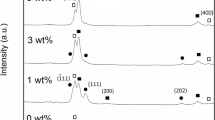Abstract
Cuprous oxide (Cu2O) thin films have been deposited on glass substrate by reactive magnetron sputtering method using Cu target and argon oxygen gas atmosphere. Effect of oxygen flow rate on structural and optical properties of thin films has been discussed. The results of X-ray diffraction, ultraviolet-visible spectrophotometry and atomic force micrograph indicated that the condition window for single Cu2O phase was about 3.8 to 4.4 cm3/min, and the optimum oxygen flow rate was 4.2 cm3/min. The optical band gap E g of Cu2O film was determined by using the data of transmittance versus wavelength, and slightly decreased from 2.46 to 2.40 eV with the increase of oxygen flow rate from 3.8 to 4.4 cm3/min. The Cu2O film formed at the oxygen flow rate of 4.2 cm3/min had an optical band gap of 2.43 eV.
Similar content being viewed by others
References
Rai B P. Cu2O solar cells: A review [J]. Solar Cells, 1988, 25(3): 265–272.
Akimoto K, Ishizuka S, Yanagita M, et al. Thin film deposition of Cu2O and application for solar cells [J]. Solar Energy, 2006, 80(6): 715–722.
Ogwu A A, Darma T H, Bouquerel E. Electrical resistivity of copper oxide thin films prepared by reactive magnetron sputtering [J]. Journal of Achievements in Materials and Manufacturing Engineering, 2007, 24(1): 172–177.
Mittiga A, Salza E, Sarto F, et al. Heterojunction solar cell with 2% efficiency based on a Cu2O substrate [J]. Applied Physics Letters, 2006, 88(16): 163502–163504.
Chen A P, Long H, Li X C, et al. Controlled growth and characteristics of single-phase Cu2O and CuO films by pulsed laser deposition [J]. Vacuum, 2009, 83(6): 927–930.
Ogwu A A, Bouquerel E, Ademosu O, et al. The influence of rf powder and oxygen flow rate during deposition on the optical transmittance of copper oxide thin films prepared by reactive magnetron sputtering [J]. Journal of Physicsl D: Applied Physics, 2005, 38(2): 266–271.
Michael N. Defects in Cu2O, CuAlO2 and SrCu2O2 transparent conducting oxides [J]. Thin Solid Films, 2008, 516(22): 8130–8135.
Raebiger H, Lany S, Zunger A. Origins of the ptype nature and cation deficiency in Cu2O and related materials [J]. Physical Review B, 2007, 76(4): 045209–045213.
Tsur Y, Riess I. Self-compensation in semiconductors [J]. Physical Review B, 1999, 60(11): 8138–8146.
Mittiga A, Biccari F, Malerba C. Intrinsic defects and metastability effects in Cu2O [J]. Thin Solid Films, 2009, 517(7): 2469–2472.
Li B B, Lin L, Shen H L, et al. Effect of N doping on hole density of Cu2O: N films prepared by the reactive magnetron sputtering method [J]. The European Physical Journal Applied Physics, 2012, 58(2): 1–4.
Minami T, Miyata T, Ihara K, et al. Effect of ZnO film deposition methods on the photovoltaic properties of ZnO-Cu2O heterojunction devices [J]. Thin Solid Films, 2006, 494(1-2): 47–52.
Jeong S S, Mittiga A, Salza E, et al. Electrodeposited ZnO/Cu2O heterojunction solar cells [J]. Electrochimica Acta, 2008, 53(5): 2226–2231.
Ishizuka S, Suzuki K, Okamoto Y, et al. Polycrystalline n-ZnO/p-Cu2O heterojunctions grown by RFmagnetron sputtering [J]. Physica Status Solidi (C), 2004, 1(4): 1067–1070.
Al-Kukaili M F. Characterization of copper oxide thin films deposited by the thermal evaporation of cuprous oxide (Cu2O) [J]. Vacuum, 2008, 82(6): 623–629.
Yang W Y, Kim W G, Rhee S W, Radio frequency sputter deposition of single phase cuprous oxide using Cu2O as a target material and its resistive switching properties [J]. Thin Solid Films, 2008, 517(2): 967–971.
Chen A P, Long H, Li X C, et al. Controlled growth and characteristics of single-phase Cu2O and CuO films by pulsed laser deposition [J]. Vacuum, 2009, 83(6): 927–930.
Liu Y L, Liu Y C, Mu R, et al. The structural and optical properties of Cu2O films electrodeposited on different substrates [J]. Semiconductor Science and Technology, 2005, 20(1): 44–48.
Li B S, Akimoto K, Shen A. Growth of Cu2 O thin films with high hole mobility by introducing a low-temperature buffer layer [J]. Journal of Crystal Growth, 2009, 311(4): 1102–1105.
Zhu H L, Zhang J Y, Li C Z, et al. Cu2O thin films deposited by reactive direct current magnetron sputtering [J]. Thin Solid Films, 2009, 517(19): 5700–5704.
Losev A, Rostov K, Tyeliev G. Electron beam induced reduction of CuO in the presence of a surface carbonaceous layer: An XPS/HREELS study [J]. Surface Science, 1989, 213(2–3): 564–579.
Takahiro I, Kunisuke M. Growth process of CuO(1 1 1) and Cu2 O(0 0 1) thin films on MgO(0 0 1) substrate under metal-mode condition by reactive dc-magnetron sputtering [J]. Vacuum, 2007, 81(9): 1068–1076.
Reddy A S, Rao G V, Uthanna S, et al. Structural and optical studies on dc reactive magnetron sputtered Cu2O films [J]. Materials Letters, 2006, 60(13–14): 1617–1621.
Necmi S, Tulay S, Seyda H, et al. Annealing effects on the properties of copper oxide thin films prepared by chemical deposition [J]. Semiconductor Science and Technology, 2005, 20(5): 398–402.
Pierson J F, Thobor-Keck A, Billard A. Cuprite, paramelaconite and tenorite films deposited by reactive magnetron sputtering [J]. Applied Surface Science, 2003, 210(3–4): 359–367.
Author information
Authors and Affiliations
Corresponding author
Additional information
Foundation item: the National Natural Science Foundation of China (No. 61176062) and the Fundamental Research Funds for the Central Universities (No. NZ2012309)
Rights and permissions
About this article
Cite this article
Li, Bb., Zhu, Jx., Chen, Zf. et al. Effect of oxygen content on structural and optical properties of single Cu2O film by reactive magnetron sputtering method. J. Shanghai Jiaotong Univ. (Sci.) 17, 523–526 (2012). https://doi.org/10.1007/s12204-012-1318-5
Received:
Published:
Issue Date:
DOI: https://doi.org/10.1007/s12204-012-1318-5




